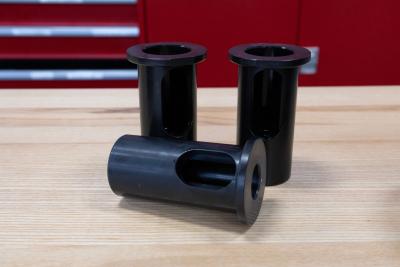
Allied Machine and Engineering, a leading manufacturer of holemaking and finishing cutting tools for the metal-cutting industry, announces the launch of threaded lathe sleeves as a stocked-standard way to induce coolant to newer style holders without rear pipe taps. Ideal for smaller job shops using aging lathes, the threaded lathe sleeves are targeted for use on machines that do not have the capability to run through-the-turret coolant.
In an effort to bring new age drilling technologies to aging machines where high-speed drilling was not thought possible, Allied Machine’s goal is to make new cutting tool advancements more accessible. Across the general machining industry, customers are able to directly plumb in an external coolant line to the back of the sleeve using a standard ½ NPT or ½ BSP pipe fitting. This also gives users the option to adapt external high-pressure pumps directly to a turret station to maximize pressure and flow for long/deep holes.
As the manufacturing industry continues to push for drilling solutions with faster penetration rates, drill bodies have evolved to meet these needs with added coolant inlets and outlets. In doing so, the traditional rear pipe tap method of inducing coolant has been lost in many cases. At the same time, with continued innovation comes the risk of alienating those who have built their businesses centered around machinery that has stood the test of time. Because of this, the launch of the threaded lathe sleeves is “just another example of Allied’s continued effort to bring machine shops, small and large, into the new age of drilling,” explains John Weniger, product manager.
Contact Details
Related Glossary Terms
- coolant
coolant
Fluid that reduces temperature buildup at the tool/workpiece interface during machining. Normally takes the form of a liquid such as soluble or chemical mixtures (semisynthetic, synthetic) but can be pressurized air or other gas. Because of water’s ability to absorb great quantities of heat, it is widely used as a coolant and vehicle for various cutting compounds, with the water-to-compound ratio varying with the machining task. See cutting fluid; semisynthetic cutting fluid; soluble-oil cutting fluid; synthetic cutting fluid.
- lathe
lathe
Turning machine capable of sawing, milling, grinding, gear-cutting, drilling, reaming, boring, threading, facing, chamfering, grooving, knurling, spinning, parting, necking, taper-cutting, and cam- and eccentric-cutting, as well as step- and straight-turning. Comes in a variety of forms, ranging from manual to semiautomatic to fully automatic, with major types being engine lathes, turning and contouring lathes, turret lathes and numerical-control lathes. The engine lathe consists of a headstock and spindle, tailstock, bed, carriage (complete with apron) and cross slides. Features include gear- (speed) and feed-selector levers, toolpost, compound rest, lead screw and reversing lead screw, threading dial and rapid-traverse lever. Special lathe types include through-the-spindle, camshaft and crankshaft, brake drum and rotor, spinning and gun-barrel machines. Toolroom and bench lathes are used for precision work; the former for tool-and-die work and similar tasks, the latter for small workpieces (instruments, watches), normally without a power feed. Models are typically designated according to their “swing,” or the largest-diameter workpiece that can be rotated; bed length, or the distance between centers; and horsepower generated. See turning machine.
- tap
tap
Cylindrical tool that cuts internal threads and has flutes to remove chips and carry tapping fluid to the point of cut. Normally used on a drill press or tapping machine but also may be operated manually. See tapping.

